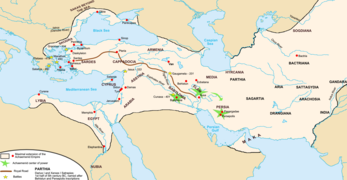Median and Achaemenid Empire (650 BC–330 BC)[edit]
Main articles: Median Empire and Achaemenid Empire
In 646 BC, The Assyrian king Ashurbanipal sacked Susa, which ended Elamite supremacy in the region.[29] For over 150 years Assyrian kings of nearby Northern Mesopotamia were seeking to conquer Median tribesof Western Iran.[30] Under pressure from the Assyrian empire, the small kingdoms of the western Iranian plateau coalesced into increasingly larger and more centralized states.[29]
In the second half of the 7th century BC, the Median tribes gained their independence and were united by Deioces. In 612 BC Cyaxares the Great, Deioces' grandson, and the Babylonian king Nabopolassar invaded Assyria and laid siege to and eventually destroyed Nineveh, the Assyrian capital, which led to the fall of the Neo-Assyrian Empire.[31] The Medes are credited with the foundation of Iran as a nation and empire, and established the first Iranian empire, the largest of its day until Cyrus the Great established a unified empire of the Medes and Persians leading to the Achaemenian Empire (c.550–330 BC).
Cyrus the Great overthrew, in turn, Median Empire, Lydian Empire, and Neo-Babylonian Empire, creating an empire far larger than Assyria. He was better able, through more benign policies, to reconcile his subjects to Persian rule; and the longevity of his empire was one result. The Persian king, like the Assyrian, was also "King of Kings", xšāyaθiya xšāyaθiyānām (shāhanshāh in modern Persian) – "great king," Megas Basileus, as known by the Greeks.
Cyrus's son, Cambyses II, conquered the last major power of the region, Ancient Egypt, causing the collapse of the Dynasty XXVI. Since he became ill and died before, or while, leaving Egypt, stories developed, as related by Herodotus, that he was struck down for impiety against the Egyptian pantheon. Be that as it may, it led to a succession crisis. The winner, Darius I of Persia, based his claim on membership in a collateral line of the Achaemenid Dynasty.
Darius' first capital was at Susa, and he started the building programme at Persepolis. He rebuilt a canal between the Nile and the Red Sea, a forerunner of the modern Suez Canal. He improved the extensive road system, and it is during his reign that mention is first made of the Royal Road (shown on map), a great highway stretching all the way from Susa to Sardis with posting stations at regular intervals. Major reforms took place under Darius. Coinage, in the form of the daric (gold coin) and the shekel (silver coin) was standardized (coinage had already been invented over a century before in Lydia c. 660 BC but not standardized),[32]and administrative efficiency was increased.
The Old Persian language appears in royal inscriptions, written in a specially adapted version of cuneiform. Under Cyrus the Great and Darius the Great, the Persian Empire eventually became the largest empire in human history up until that point, ruling and administrating over most of the then known world.[33] Their greatest achievement was the empire itself. The Persian Empire represented the world's first superpower[1][34]that was based on a model of tolerance and respect for other cultures and religions.[35]
In 499 BC, Athens lent support to a revolt in Miletus which resulted in the sacking of Sardis. This led to an Achaemenid campaign against Greece known as the Greco-Persian Wars which lasted the first half of the 5th century BC. During the Greco-Persian wars Persia made some major advantages and razed Athens in 480 BC, but after a string of Greek victories the Persians were forced to withdraw while losing control of Macedonia, Thrace and Ionia. Fighting ended with the peace of Callias in 449 BC. In 404 BC following the death of Darius II Egypt rebelled under Amyrtaeus. Later Egyptian Pharaohs successfully resisted Persian attempts to reconquer Egypt until 343 BC when Egypt was reconquered by Artaxerxes III.





No comments:
Post a Comment